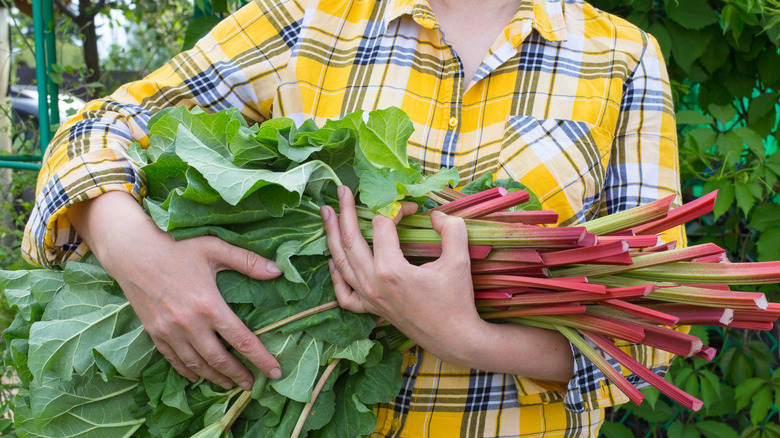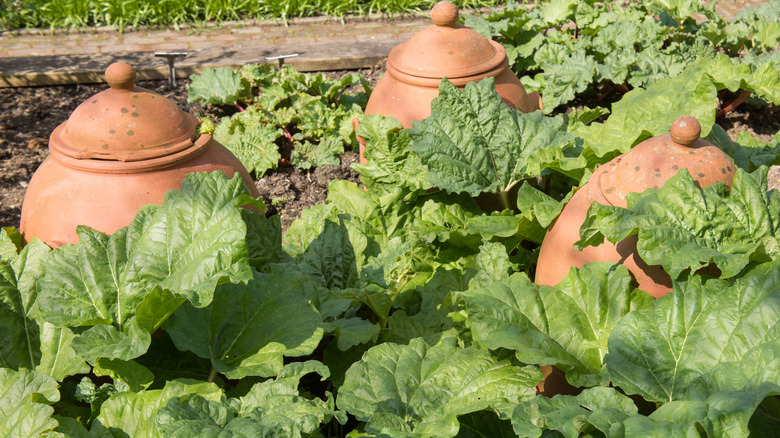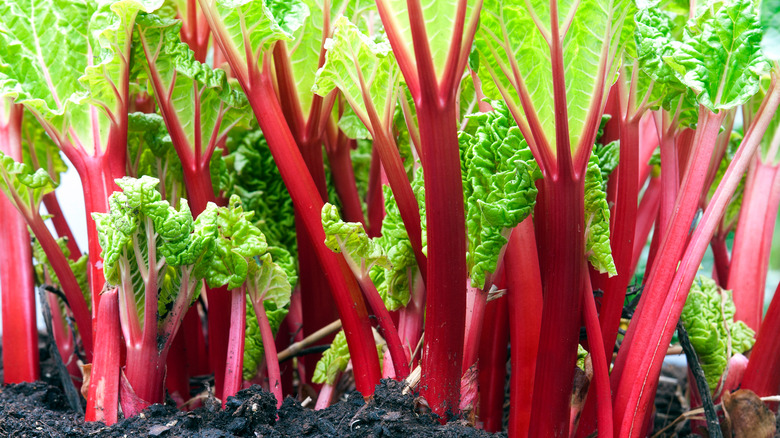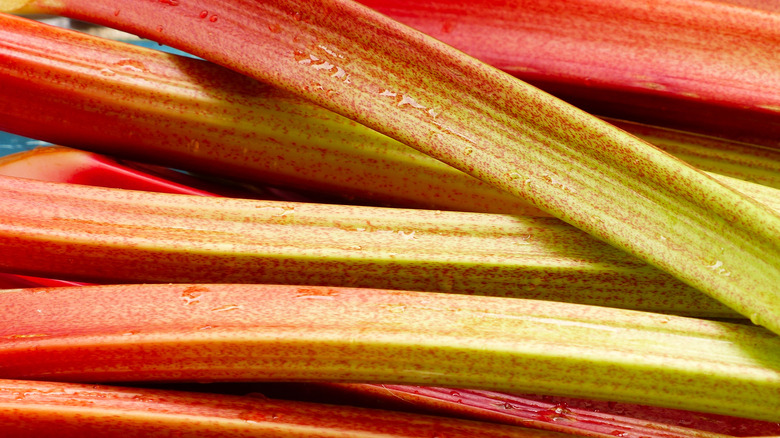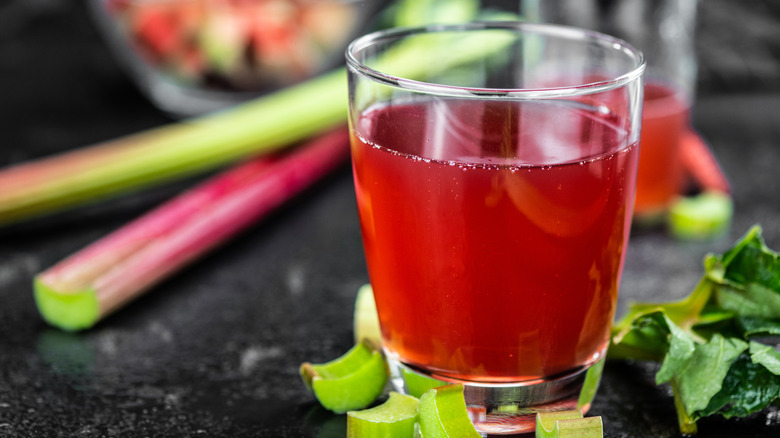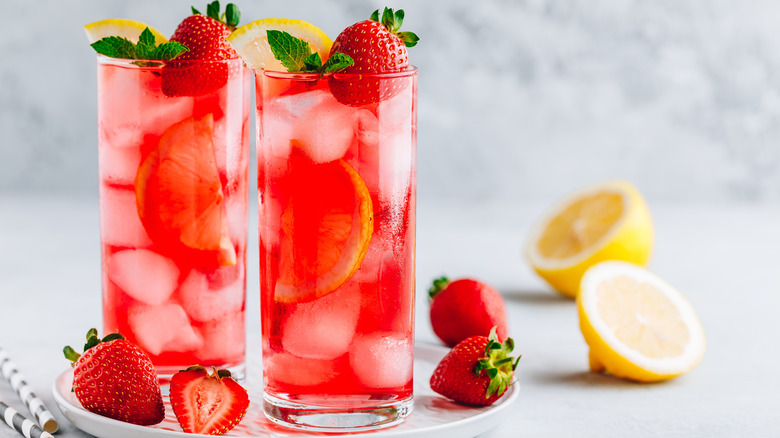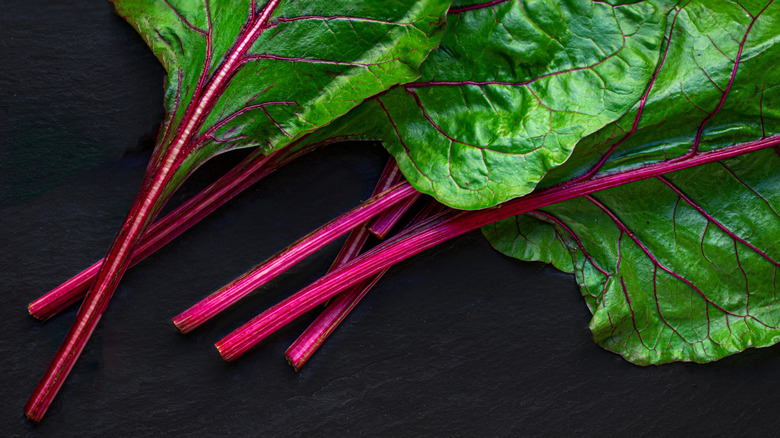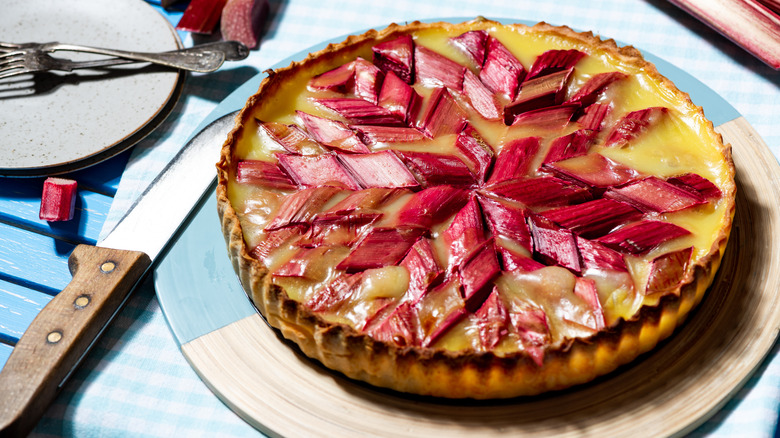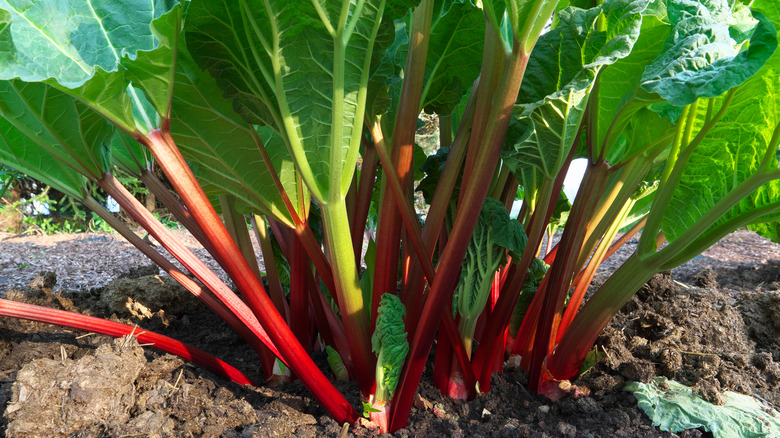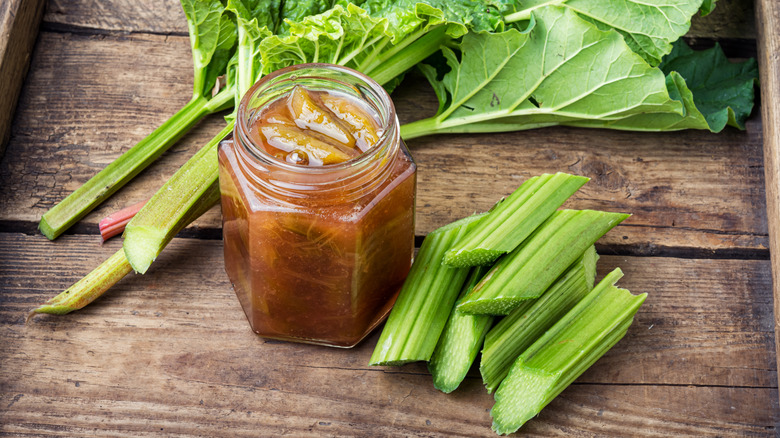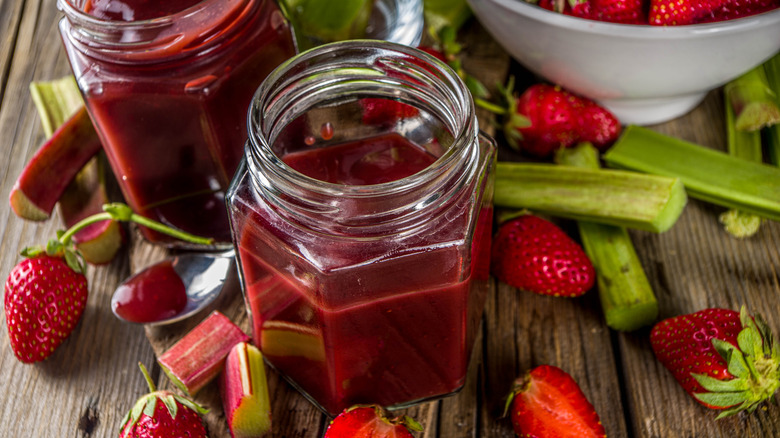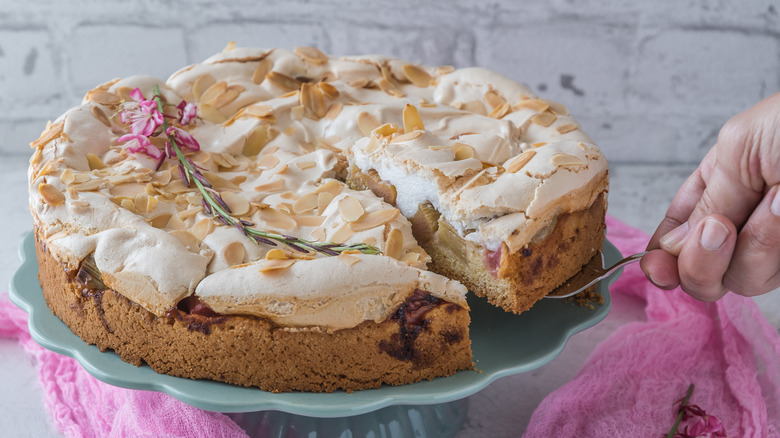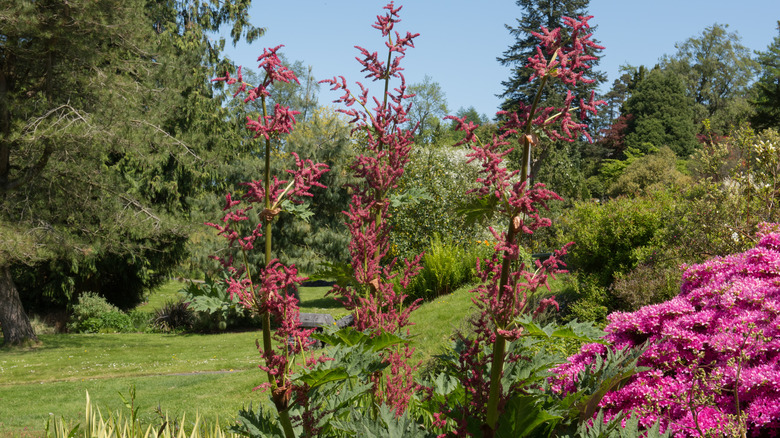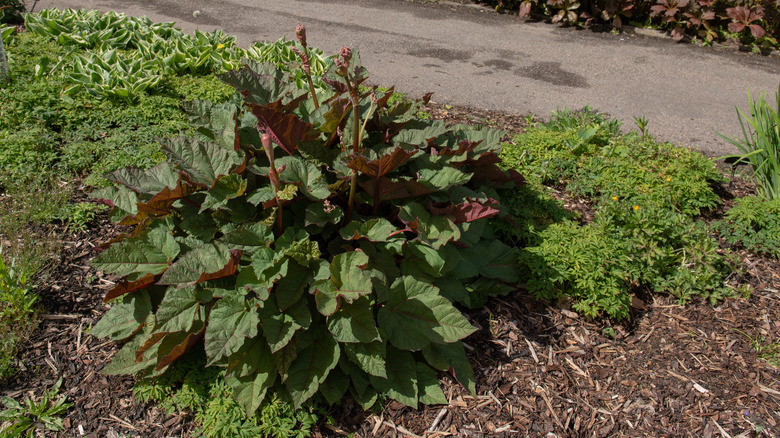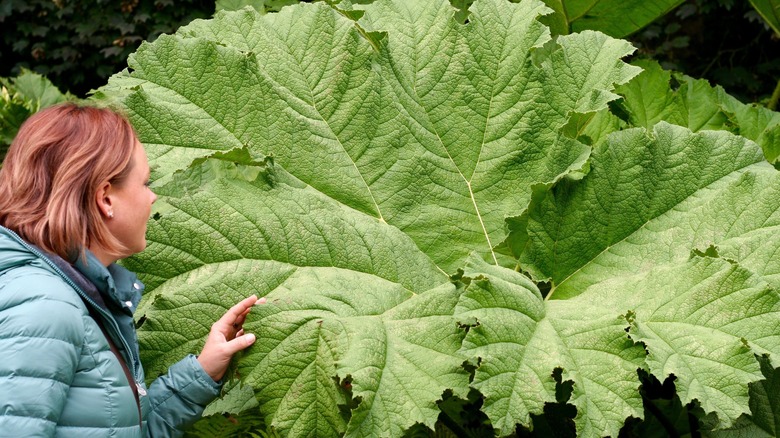14 Types Of Rhubarb And What Makes Them Unique
Rhubarb is a popular spring vegetable. The eye-catching, colorful stalks are the most edible parts of the plant. The root was predominantly used for centuries as a medicinal herb in places such as China and Greece to treat intestinal issues, swelling, fever, and more. In fact, rhubarb is still used today for its medicinal properties. The leaves are toxic, and eating them can lead to kidney problems among other ailments, so it's best to steer clear of them. You can read our guide on baking with rhubarb for more information about eating it safely.
Despite being a favorite ingredient in baked goods in the United States, such as pies and crumbles, rhubarb stalks are on the sour side. This is why rhubarb is often mixed with a lot of sugar or paired with sweeter fruits like strawberries. Fans of sour food, however, might enjoy munching on the raw stalks of rhubarb.
There are countless different varieties of rhubarb and each differs in terms of taste, color, size, and so on. If you're looking to cook with rhubarb, there are a few different popular types of this plant that are worth paying particular attention to.
1. Victoria
Victoria rhubarb is named in honor of Queen Victoria, the long-reigning English monarch. It was introduced in 1837, the first year of Queen Victoria's reign. Victoria Rhubarb's bright red, thick, and tender stems set it apart from other types of rhubarb. According to Mother Earth News, the Victoria variety has long been used as an ingredient in dessert recipes.
Victoria rhubarb can grow in a wide geographical range, thriving in USDA Hardiness Zones 3 to 8, which includes areas in the deep South (via McKay Nursery Company). This type of rhubarb is a hardy, large plant that takes up a lot of space. The leaves alone can be up to 4 feet in length, so you will want plenty of room in your garden for this one. They require pruning every four to five years. This plant will make a wonderful addition to any garden. The large, juicy stalks are tailor-made for pies, jams, and sauces.
2. Holsteiner Blut
The Holstein Blood, sometimes also known as the Holsteiner Blut (blut is German for blood) is another famously red rhubarb variety. True to its name, the stalks are a strikingly deep red color, which is caused by a high level of anthocyanins. Anthocyanins are naturally occurring antioxidants; according to studies, they have a positive effect on high blood pressure in patients with hypertension.
Due to the juiciness and sweetness of the Holstein Blood Red, it is well suited for baking into desserts such as strawberry rhubarb pie as well as sherbert. The Holstein Blood Red is also used for flavoring beverages. Its USDA plant hardiness zones are 7 to 9 annually and 3 to 6 perennially. The leaves have are wrinkles and shiny. Between the leaves and the blood-red stalks, the Holsteiner Blut makes for a beautiful ornamental plant and can be used for decoration as well as consumption.
3. Timperley Early
The hardy Timperley Early is named after the fact that it tends to mature earlier in the season than other varieties of rhubarb (via Gardeners' World). Depending on where it is grown, Timperley Early rhubarb can be harvested as soon as February, especially if forced. Forcing, which is common with rhubarb, involves coaxing a plant to grow earlier than it would normally by creating conditions of enhanced warmth.
The stalks are pink with a red base and turn green and freckled near the broad, green leaves. Timperley Early does best in USDA plant hardiness zones 7 to 9 and can grow as tall as two feet. This rhubarb, with its sweet and succulent stems, is great for cooking and mixing into oatmeal. It also works well in crumbles, tarts, and other treats to keep you warm in winter. This rhubarb can also be sliced raw into a green salad for a sweet-tart taste.
4. German Wine
The thick, sweet, and juicy red stalks of the German Wine rhubarb variety make it an excellent choice for canning, using in pies, making jam, as well as wine. A wine that is made from something other than grapes is called a country wine. Making a country wine is similar to making conventional wine from grapes, but there are a few key differences. Grapes are already high in sugar and tannins by nature. For this reason, when making wine from other fruits (or in this case a vegetable), tannins need to be added to the juice for it to achieve the ideal characteristics.
The sugar is for the wine yeast to feast on and turn into alcohol. Tannins are what make your lips pucker, however slightly, when drinking wine. So, if you're looking to turn your rhubarb into wine, the German Wine rhubarb variety was literally made for this precise endeavor. Its USDA plant hardiness zones are 3 to 8.
5. Frambozen Rood
The Frambozen Rood (meaning "raspberry red" in Dutch) is a popular variety of rhubarb known for its sweetness. This variety is often made into nectar. Rhubarb nectar is a commercially available beverage, but you can also make it at home. While rhubarb is naturally low in sugar, some sugar is added to sweeten the nectar.
Rhubarb is high in certain vitamins and minerals (such as calcium), making rhubarb nectar a wonderful addition to a refreshing and healthy summer drink. You can also add carbonated water to give it some fizz, use it in a cocktail, or mix it with lemonade. Use your imagination. The possibilities are truly endless.
Frambozen Rood grows best in USDA plant hardiness zones 7 through 9. This is a very productive plant that grows up to 5 feet tall. It can be harvested in both spring and fall, offering a steady supply of nectar for much of the year.
6. KangaRhu
A recently cultivated rhubarb variety with a cute name is the KangaRhu by the Indiana-based Gurney's Seed and Nursery Company. They started with seeds from a heat-tolerant Australian plant, hence the clever name. In 2020, the KangaRhu won a Direct Gardening Association Green Thumb Award.
Most varieties of rhubarb start to produce flowers (known as bolting) when the heat of summer hits. Gurney's wanted to produce a varietal that would resist the lure of going to seed, making it possible to continue harvesting into the summertime. They succeeded, and that's part of what sets the KangaRhu apart from its fellow rhubarbs.
The stalk of the KangaRhu is an impressively deep red that contrasts starkly with its green leaves. The color stays vibrant after cooking. Its USDA plant hardiness zones are an expansive 4 to 8. It's a versatile rhubarb good in baked goods, pureed or made into compotes, or sliced into green salads.
7. Grandad's Favorite
Grandad's Favorite (also Grandad's Favourite) rhubarb won an Award of Garden Merit from the U.K.'s Royal Horticultural Society (RHS) in 2003 (via Shoot Gardening). Growing to a height of only about three feet and spreading three feet wide, this rhubarb does well in containers. The RHS considers the Grandad's Favorite to be "suitable for showing" in gardening competitions.
Besides being attractive, this frost hardy, red-stemmed rhubarb matures in early spring (sooner if forced) and like other varieties can be used in cooking, baking, and beverages. The compact size also makes it suitable as a border plant. The crinkled dark green leaves add visual texture, and if allowed, it produces large floral panicles in the summer (Removing the flowers is recommended if the plant is being harvested for food).
This is another rhubarb with a USDA plant hardiness zone span of 7 to 9. It's a good plant for beginning gardeners and has lower toxicity than other cultivars.
8. Crimson Cherry
Crimson Cherry rhubarb has a beautiful, thick ruby-red stalk that fades to green at the leaves. It can grow up to four feet tall, which really shows off that color. It is a hardy, low maintenance, cold-resistant variety with USDA plant hardiness zones 3 to 7, though it performs best in the colder regions. For example, it is one of the most popular rhubarb types grown in Alaska.
Mature Crimson Cherry stalks can usually be harvested in the later spring to early summer, offering plenty of crop to use. The texture of the stalks is tender, and the flavor is sweet. This makes the Crimson Cherry great to eat raw, sliced into a green salad, made into baked goods, canned, or sauced. It's a solid, all-around variety that is versatile in cooking and attractive in the home garden, which sets it apart from many of its more specialized peers.
9. Riverside Giant
The Riverside Giant (which is different from the Giant Rhubarb mentioned further down the list) lives up to its name in more ways than one (via Food Gardening Network). This hardy rhubarb spans USDA plant hardiness zones 3 to 7. Also, it can withstand temperatures as chilly as minus 40 degrees, making this a truly remarkable plant. It is also long-lived with a 20-year (give or take) lifespan. Unlike many of the other varieties of rhubarb on this list, Riverside Giant is green rather than pink or red.
However, the Riverside Giant is also a slow-growing variety, so it may be three years between harvests. Happily, the thick, green stem is edible and can be used in baked goods, jams, and sauces like other rhubarb. Canning a harvest means there will still be some around in the cupboards while you are waiting for the next crop to mature.
10. Glaskins Perpetual
Glaskins Perpetual is another frost hardy, low-acid rhubarb variety that first appeared in England in the 1920s. The low acid level makes the plant capable of being harvested as late as July and is the source of the name "perpetual." It has a broad USDA plant hardiness, from 3 to 8, but performs best in cooler regions. It's a small plant with both a height and spread max of two feet. The flowers, though, if allowed to progress, can reach up to six feet tall.
Another thing that makes this rhubarb unique is that it can be grown from seed. It is more common to divide an already established plant and transplant it to a new location. Some plant nurseries and online sources also sell roots.
The long, succulent red stalks are great in jams, pies, and wine. The lower acidity makes the flavor less bitter than other rhubarbs, though still tart.
11. Sunrise
The top quality of the Sunrise rhubarb that sets it apart from every other entry on this list is its color (via Gardening Know How). This variety's stalk is pink that fades into green at the leaves, hence its name. It has a thick stalk that maintains its texture in canning and freezing (for those off-season cravings), but it can also be used in baked goods and to make jams and sauces. First cultivated in the 1940s, the Sunrise variety is a reliable, heavy producer, especially when forced.
The Sunrise is a perfect fit for those looking for something different than the traditional red rhubarb. It grows well in USDA plant hardiness zones 3 to 8, and can become as large as three feet high and three feet broad. This makes it somewhat compact when compared to other varietals. The pink stalks would also be a lovely addition to border gardens.
12. Chinese Rhubarb
With its brightly colored stalks and large, eye-catching green leaves, it's no wonder that people use rhubarb as an ornamental plant in landscaping and in pots on porches and patios. What is most commonly called Chinese Rhubarb, specifically rheum palmatum, is just such an ornamental specialty. (Another name you will often see for rheum palmatum is Turkey Rhubarb. The botanical name is the key for correctly identifying this rhubarb.)
It originated in China, as its name suggests. For countless centuries, the root has been dried, ground to a powder, and used in traditional Chinese medicine (via The Herbal Resource). In its natural habitat, Chinese Rhubarb grows wild and is sometimes seen as a weed.
With a USDA plant hardiness of zones 6 to 9, Chinese Rhubarb thrives in wet soil. It can grow over eight feet tall with leaves two and a half feet across. Like other rhubarbs, this one flowers in the summer with large panicles and petals of white to pink.
13. Ace of Hearts
The Ace of Hearts, or sometimes Ace of Spades, rhubarb is named from the heart- (or spade-) shaped leaves, which start the growing season red and change to dark green with red undersides with maturity. Because this variety was uniquely cultivated for its looks, the stalks are not edible. It was given a Royal Horticultural Society's Award of Garden Merit.
A hybrid of Chinese Rhubarb and Dwarf Rhubarb, the Ace of Hearts loves a wet environment, but is more compact for a smaller garden or a modest backyard pond. While still petite, this variety can grow to three to five feet tall and spread two to three feet. Pink flowers emerge on tall stalks in the summer.
This is a sturdy plant, suited to USDA plant hardiness zones 5 through 9, that was designed for small garden plots and does well in border gardens — as long as there's plenty of moisture.
14. Giant Rhubarb
Another popular ornamental rhubarb is the Giant Rhubarb (which is different from the Riverside Giant mentioned above). It has long, spiky green stalks and large frilly leaves, making it a lovely and impressive addition to any garden.
All right, technically speaking, Giant Rhubarb isn't a rhubarb at all. It is of the Gunneraceae family, not the Polygonaceae family to which rhubarb (rheum) belongs. It came to be called Giant Rhubarb because, frankly, it looks like rhubarb — giant rhubarb. Stalks can grow to ten feet and leaves are up to six feet across. It is one of the largest perennials that can still fit into a home garden. Originally from southern Brazil, its USDA plant hardiness level is 8.
Unlike actual rhubarb (rheum), Giant Rhubarb is not poisonous, though its bitter flavor makes it nearly inedible. It does, however, like its doppelganger, have some medicinal properties. Studies have found Giant Rhubarb extract to be antimicrobial.
